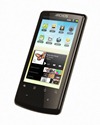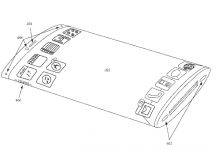 I’ve greatly enjoyed the two 1st-generation iPod Touch pocket-sized media/Internet devices I’ve had over the last few years, and have had my eyes on the 4th-generation iPod Touch for some little while. I’ve been thinking that, come the fall, I might upgrade to a 4th-gen model when the 5th-gen iPod Touch comes out and drives refurb prices down.
I’ve greatly enjoyed the two 1st-generation iPod Touch pocket-sized media/Internet devices I’ve had over the last few years, and have had my eyes on the 4th-generation iPod Touch for some little while. I’ve been thinking that, come the fall, I might upgrade to a 4th-gen model when the 5th-gen iPod Touch comes out and drives refurb prices down.
From a features perspective, the iPod Touch has just about everything I could want: a high-quality, highly-sensitive touchscreen, excellent e-book reading capability (even without iBooks available on the 1st-generation model, I’ve got Stanza so I have no complaints there), great web browsing, e-mail, and social-networking abilities given its form factor—and it even plays videos and mp3s, too! And all this on a device that slips easily into my pocket to be with me anywhere I go, and doesn’t force me to pay through the nose for a smartphone subscription.
But lately, Apple’s moves toward driving e-book and other media vendors away from the platform (with its insistence on in-app purchase availability for a 30% fee) have started me thinking that perhaps I should look into an Android-based alternative. I do have a lot of iPod apps, but nothing I can’t really live without. Most of my music is DRM-free, thanks to Apple’s moves in that direction a couple of years ago. And most of my e-books are DRM-free, too, and there are Android reader apps for many of those that aren’t.
The problem is, I can’t really seem to find an Android-based alternative that’s anywhere near as good as the iPod Touch. My search has once again brought home to me that, for all that Apple can have obnoxiously restrictive policies, it has a genius for consumer device design that is still unmatched by a lot of competitors. You wouldn’t think it should be too hard to create a “phoneless smartphone” microtablet that you can carry in your pocket and surf the net with, but there doesn’t seem to be anything out there that is good at doing everything the iPod Touch does.
Until recently, the closest things were made by Archos, which does have a number of years of handheld media jukebox experience to draw on. The Archos 5 seems to come in for a lot of iPod Touch comparisons, though its 5” screen makes it equivalent in size to the Kobo Reader rather than the iPod Touch—somewhat harder to carry in a pocket. And as CNet’s review points out, it makes a lot better video player than general-purpose tablet.
Perhaps a bit closer to the iPod Touch’s form factor are the Archos 28, 32, and 43 devices, which have 2.8, 3.2, and 4.3 inch screens respectively. Engadget seems to think the 32 does come fairly close to the Touch in usability, However, they share certain key drawbacks with the 5. (Hmm, by that naming scheme, shouldn’t the 5 actually be the “50”? Oh well, nobody said device names had to make sense.)
One of those drawbacks is that these devices all have resistive touchscreens (the less-sensitive kind of touchscreen, as was used on the Palm Pilot, that essentially needs a stylus or fingernail to recognize a tap) rather than the iPod Touch’s awesomely sensitive capacitive touchscreen. But a bigger drawback is that, as far as I can tell, in order to put the Android Market onto any of them, you basically have to use a hack.
The reason for this is that Google doesn’t want non-phone or non-3G-capable devices to have access to its store. (Cheap hardware importer Augen got in trouble for that last year when it sold a tablet with a “testing version” of the Android Market included, without Google’s blessing.)
As Kevin C. Tofel pointed out on GigaOM last year, this has the effect of limiting Android devices’ ability to compete in the non-smartphone tablet market, restricting them from accessing even basic Google applications like Gmail. But Google says that Android (or at least the version of it these devices run) is “not yet designed for tablets” and the company does not want to support tablets until it has a version of Android that is.
But it seems that Samsung may have changed Google’s mind. I was getting ready to close out this article decrying the availability of anything other than the lackluster Archos devices when I happened to notice some articles about the upcoming Samsung Galaxy Player 4 and 5, which are 4” and 5” phoneless versions of the Galaxy S smartphone that reportedly will have both a capacitive touchscreen and access to the Android Market. They feature Android 2.2 and are theoretically upgradable to Android 2.3 (though Samsung isn’t making any promises).
The Galaxy Player isn’t on the US market yet, and it’s not clear what it will cost when it is. A 3.2”-screen version did hit Amazon.co.uk in January at a price of £149 ($248 at current exchange rates) for an 8-gig and £180 ($300) for a 16-gig version. It’s clear that these are going to be devices to watch (though this review of that earlier 3.2” version is not very positive).
There don’t seem to be any other Android microtablets in the same functionality range as the Touch apart from those Archos devices and the not-yet-available Samsung. It’s kind of weird when you think about it—tablet manufacturers get a lot of attention for trying to come up with devices that will “kill” the iPad, but it’s almost like nobody notices or thinks about the iPod Touch, even though it fills its niche as well as or better than the iPad.
Perhaps it fills it so well nobody else even thinks of trying to compete there beyond a few half-hearted media jukebox efforts (and, of course, Microsoft’s Zune, which isn’t Android and has been a significant flop, though Microsoft claims it’s not dead yet). I guess we’ll just have to see how well the Samsung does.































chris – you are spot on.
i had been wanting an iPod touch for many months and my husband finally gave me a 3G iPod touch for christmas. it’s been christmas every day since. it is a device, like post-it notes, where you ask yourself, “how did i live without this?”
my youngest son pays verizon $35/month, bought his mi-fi card from a 3rd party and now uses his 4G iPod touch as his main phone.
i’ve seen android smartphones and have been intrigued, but the data plans will always bring me back to my iPod. it’s everything i need and it fits in my pocket.
thanx for the article. saves me a lot of time looking for something that i already have. 🙂
CREATIVE ZEN Touch 2 available right now with android 2.2, with and without GPS, digital compass, etc…
Argh. I approved a post out of the spam folder to here, but it up and vanished. Sorry, whoever posted it. It looks like WordPress ate it.
For the price of a 32mb Touch I bought a Motorola Defy Android phone. No contract, bigger 240 dpi resolution really nice screen, GPS and of course It is a phone as well. The reason there are so few Android mediaplayers is because the phones are so affordable. The Touch only makes sense in Apple’s universum.
Interesting. Is that phone available on a pay-as-you-go basis? From what provider?
I don’t live in the US and have the option of buying either a bundled or an unbundled phone. There are a number of phones that are reasonably priced unbundled and that make excellent ereaders. My phone hardly gets used for calls – it is mainly used for surfing, the Kindle app and Words With Friends.
Boost Mobile (pay as you go) in the US has the Samsung Galaxy Prevail for $179.99, I think Virgin has one for around $200 too.
What about the new Asus Transformer? Looks good, runs Honeycomb and has an optional docking keyboard.
The Asus Transformer is just a leeeetle bit bigger than an iPod Touch. There are plenty of full-size Android tablets but the point of this post was that it’s all but impossible to find a decent Android microtablet/PDA equivalent.
The Samsung Galaxy Player is available in Costco stores in South Korea. I have a Galaxy S (smartphone) and the new Galaxy Player looks like an excellent contender.
Liliputing has a post on this topic today.
http://liliputing.com/2011/10/8-android-alternatives-to-apples-ipod-touch.html